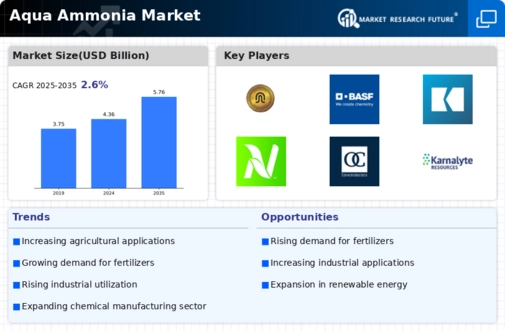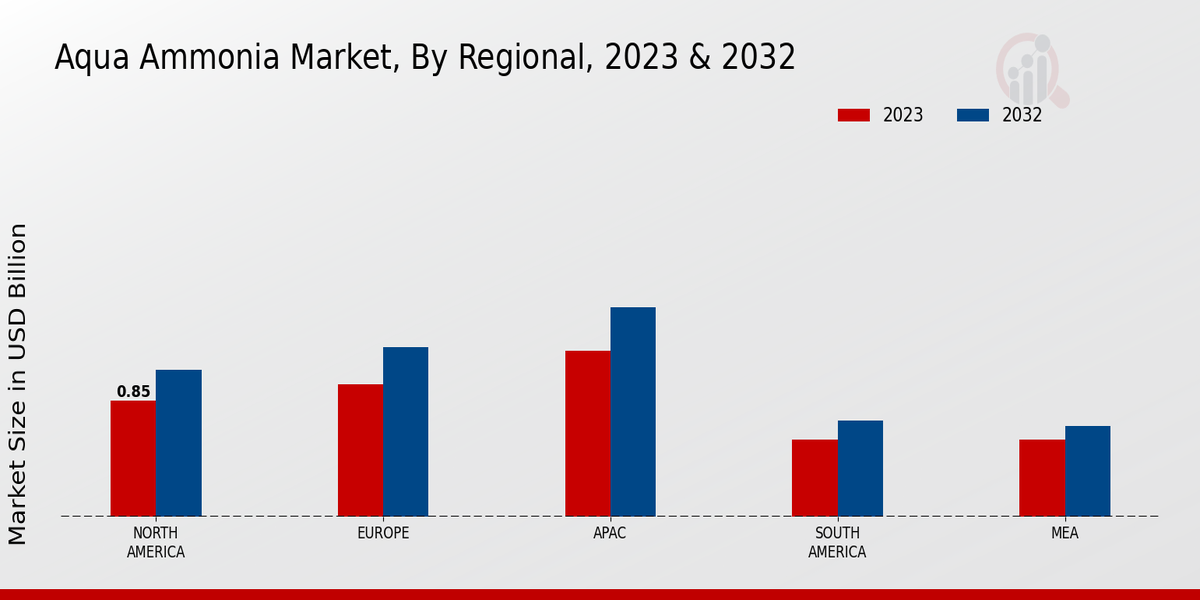Industrial Applications
The Global Aqua Ammonia Market Industry benefits from diverse industrial applications, particularly in the production of chemicals and as a refrigerant. Industries such as textiles, pharmaceuticals, and food processing utilize aqua ammonia for its effective properties. Its role in the synthesis of various chemicals, including ammonium sulfate and ammonium nitrate, underscores its importance in industrial processes. The growing industrialization across developing nations further propels the demand for aqua ammonia, as it is integral to numerous manufacturing processes. This broad applicability suggests a sustained growth trajectory for the market, aligning with the overall expansion of industrial sectors globally.
Market Growth Projections
The Global Aqua Ammonia Market Industry is poised for growth, with projections indicating a market value of 4.36 USD Billion in 2024 and an anticipated increase to 5.76 USD Billion by 2035. This growth trajectory suggests a steady demand for aqua ammonia, driven by its applications in agriculture, industry, and environmental sustainability. The compound annual growth rate (CAGR) of 2.56% from 2025 to 2035 further underscores the market's potential. These figures illustrate the increasing recognition of aqua ammonia's versatility and its role in addressing global challenges related to food security and environmental sustainability.
Rising Demand in Agriculture
The Global Aqua Ammonia Market Industry experiences a notable surge in demand from the agricultural sector, primarily due to its application as a nitrogen source in fertilizers. As the global population continues to grow, the need for efficient agricultural practices intensifies. Aqua ammonia serves as a cost-effective solution for enhancing crop yields, thus driving its adoption. In 2024, the market is projected to reach 4.36 USD Billion, reflecting the increasing reliance on nitrogenous fertilizers. This trend is expected to persist, with the market anticipated to grow at a CAGR of 2.56% from 2025 to 2035, reaching 5.76 USD Billion by 2035.
Technological Advancements in Production
Technological innovations in the production of aqua ammonia are driving efficiency and reducing costs within the Global Aqua Ammonia Market Industry. Advances in synthesis methods and process optimization have led to improved yield rates and lower energy consumption. These developments not only enhance the economic viability of aqua ammonia but also contribute to its competitive positioning against alternative nitrogen sources. As technology continues to evolve, it is expected that production capacities will expand, further supporting market growth. The integration of cutting-edge technologies may also lead to the development of more sustainable production practices, aligning with global sustainability goals.
Growing Awareness of Sustainable Practices
The Global Aqua Ammonia Market Industry is witnessing a shift towards sustainable agricultural and industrial practices. Stakeholders are increasingly recognizing the benefits of using aqua ammonia as a sustainable nitrogen source, which contributes to soil health and reduces environmental impact. This growing awareness is prompting farmers and manufacturers to adopt aqua ammonia in their operations, thereby driving market demand. As sustainability becomes a focal point in global policies and consumer preferences, the market for aqua ammonia is likely to expand. This trend reflects a broader movement towards environmentally responsible practices across various sectors.
Environmental Regulations Favoring Ammonia Solutions
The Global Aqua Ammonia Market Industry is influenced by stringent environmental regulations aimed at reducing greenhouse gas emissions. Aqua ammonia is recognized for its lower environmental impact compared to other nitrogen sources, making it a preferred choice for industries seeking to comply with sustainability standards. Governments worldwide are implementing policies that encourage the use of eco-friendly alternatives, thus bolstering the demand for aqua ammonia. This regulatory landscape not only supports market growth but also aligns with global efforts to mitigate climate change. As industries adapt to these regulations, aqua ammonia's role is likely to become increasingly prominent.
























Leave a Comment